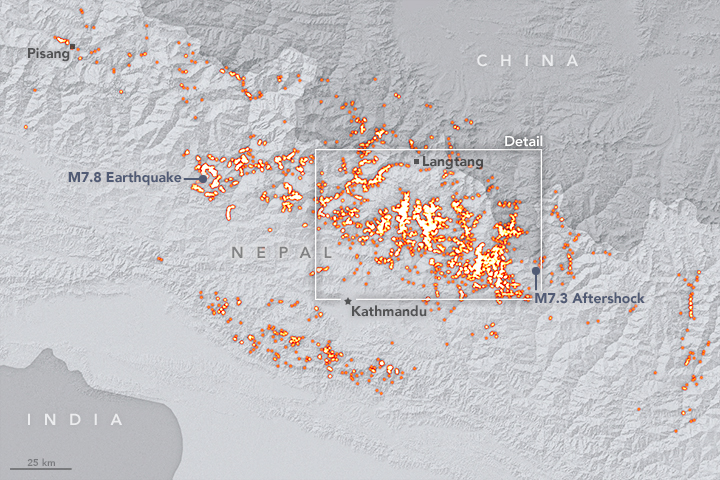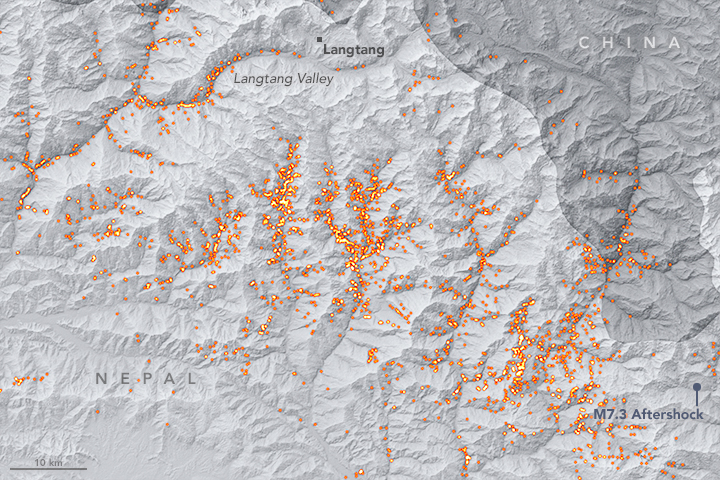Archive for December, 2015
Beijing: Another Red Alert this weekend
Saturday, December 19th, 2015https://www.youtube.com/watch?v=WsB5McsCoX8
The April 25, 2015 Nepal Earthquake (M7.8): Landslides mapped between April 25 and June 10.
Saturday, December 19th, 2015

When the Earth rumbled in the Gorkha region of Nepal in April 2015, the quake sparked aftershocks and induced dangerous hazards—including more than 4,000 landslides. Yet all of those slides were fewer and, in some ways, less damaging than expected.
Starting immediately after the magnitude 7.8 earthquake on April 25, a group of scientists organized themselves and donated their time to sift through satellite imagery and locate potentially hazardous terrain. The group redoubled their efforts when another magnitude 7.3 earthquake on May 12 triggered more landslides.
In total, this volunteer effort—led by glaciologist Jeff Kargel of the University of Arizona and coordinated with NASA—identified and mapped 4,312 landslides in the weeks following the Gorkha earthquake. The map above shows an inventory of the landslides that were mapped between April 25 and June 10. Brighter colors indicate areas with more landslides. The count stopped in June because of the onset of the monsoon season; scientists wanted to distinguish between earthquake-related landslides and those triggered by rain.
To pinpoint the locations of slides in remote areas far from the population centers of Nepal, scientist-volunteers analyzed satellite imagery acquired before and after the earthquake by 10 satellites operated by four countries. NASA data came from the Landsat satellites (joint with the U.S. Geological Survey), the Earth Observing-1 satellite, and the Advanced Spaceborne Thermal Emission and Reflection Radiometer (ASTER) on the Terra satellite. The team also reviewed media reports, eyewitness photography, field assessments from helicopters, and existing image mosaics and topographic information available through products like Google Earth.
By identifying where landslides have occurred, researchers can predict where the ground might be unstable and prone to additional hazards. In addition to landslides, the team found and mapped lakes that had been dammed lakes and remote villages that were affected.
NASA shared this information with a regional intergovernmental organization, the International Center for Integrated Mountain Development (ICIMOD) in Nepal. ICIMOD shared these findings with the Nepalese prime minister and other government officials, as well as scientific agencies, in order to make informed decisions about evacuating people and providing relief support.
The team found that the 4,312 landslides after the Gorkha earthquake were far fewer than occurred after similar-magnitude quakes in other mountainous areas. In addition, the team surveyed 491 glacial lakes and saw only nine that were affected by landslides. Satellite images did not reveal any flooding from those lakes.
“It was a really bad earthquake—over 9,000 fatalities in four countries, primarily Nepal,” said Kargel. “As horrific as this was, the situation could have been far worse for an earthquake of this magnitude.”
The research team is now investigating why there were fewer landslides than expected and why they are distributed as they are. One possible explanation is that the quake caused much less shaking at the surface than other quakes of similar magnitude.
The researchers also found that the movement of Earth’s surface influenced where the landslides occurred. Co-author Eric Fielding of NASA’s Jet Propulsion Laboratory used satellite radar imagery to create a map of the terrain that dropped and rose during the earthquake. The results revealed that Earth’s surface dropped almost 1.4 meters (5 feet) in some places, and rose as much as 1.5 meters (5 feet) in others. By overlaying Fielding’s map with the landslide map, the scientists found that most of the documented landslides occurred in areas where the ground surface dropped, rather than in areas where it was uplifted. That pattern was unexpected and hasn’t been observed before, Kargel said.
Read more about the Nepal earthquake study by clicking here.
NASA Earth Observatory maps by Joshua Stevens. Caption by Kasha Patel (GSFC) and Alan Buis (JPL).
- Instrument(s):
- Landsat 8
U.N. report: International peacekeepers in Central African Republic implicated in the alleged abuse of children between December 2013 and June 2014
Friday, December 18th, 2015** The U.N. has come under fire for its handling of the allegations
** The implicated peacekeepers were not under United Nations command at the time
** The three-member review panel harshly criticized the way the U.N. and its agencies dealt with the alleged abuse, calling it “seriously flawed” and a “gross institutional failure.”
** 3 senior U.N. officials had abused their authority by failing to take action.

CDC: Zoonotic Diseases in South Africa
Friday, December 18th, 2015Global Disease Detection Stories: Tracking and Taming Zoonotic Diseases in South Africa
A One Health program in South Africa connects physicians and veterinarians to better understand causes of human disease by looking at animals in a new light.

Collecting samples from African buffalo in Kruger National Park.
How do you tonsil swab a wild African buffalo? More importantly, why? The answer is that buffaloes are reservoirs for certain “zoonotic” diseases, or diseases that can be passed from animals to humans. Many infectious diseases (such as rabies and Rift Valley Fever) are transmitted through animals, which is why tracking animal diseases that could potentially jump to humans is a crucial aspect of public health. Early detection means spotting these diseases in animals before they make people sick.
Tracking disease in a national park
Dr. Marietjie Venter of the Global Disease Detection program in South Africa, visited Kruger National Park along with Jumari Steyn, a PhD student from the University of Pretoria. As part of a wildlife surveillance program, a skilled group of veterinarians sampled 30 buffalo in three hours. They swabbed tonsils and collected blood, fecal, and stomach content to investigate foot and mouth disease (FMD), which can cause major outbreaks in cattle if they come into contact with infected buffalo.
“Early detection means spotting diseases in animals before they make people sick.”
While buffalo are natural reservoirs for FMD, they are also thought to carry Rift Valley Fever, bovine tuberculosis, and other bacteria and viruses that could potentially spread to humans. The University’s research unit will use the collected samples to investigate for these zoonotic diseases which have been detected in wildlife, farm animals and humans.
An expanded partnership between the Centers for Disease Control and Prevention (CDC) South Africa and the University’s research unit improves surveillance capacity to include priority zoonotic diseases in the region: anthrax, brucellosis, rodent- and bat-borne pathogens, and many others. It also adds additional data collection sites and enhances reporting.
Bridging animal health and human health
Tracking diseases in domestic animals and wildlife has been happening for a long time, but linking that information to humans who are sick or could become sick has not. South Africa has strong surveillance systems; CDC’s role has been to support and expand them through its One Health program.

Buffalo are natural reservoirs for foot and mouth disease.
While it makes sense to get human and animal experts together, this is not an easy task. The One Health initiative has programs all over the world and builds bridges between people who may not otherwise work together. The success of the program lies in the regularity of the exchanges. One Health programs explores connections between human health, animal health, and the environment, bringing together experts in fields as diverse as climate change, farming practices, and wildlife management. According to Dr. Wanda Markotter, the Principal Investigator for CDC’s original agreement with the University of Pretoria, “This new project will significantly enhance the collaboration between the Health and Veterinary faculties to develop joint surveillance and diagnostic programs on zoonotic disease in South Africa and provide feedback to the Ministries of Health and Agriculture in South Africa.”
So back to that buffalo. Are you curious about how those specimens are collected?
Step 1: Tranquilizer dart.
Step 2: Apply blindfold.
Step 3: Drag with tractor to recovery area.
Step 4: Collect sample.
Step 5: Provide tranquilizer antidote.
Step 6: Run! Doctors treating humans may want to count their blessings.
A cooperative agreement between CDC and the University of Pretoria’s Zoonoses Research Unit is expanding zoonotic disease surveillance in South Africa. This work is coordinated through the GDD Center in South Africa, which is part of CDC’s country office.
CDC: In India, acute diarrheal diseases and food poisoning routinely account for over 40% of infectious disease outbreaks.
Friday, December 18th, 2015Global Disease Detection Stories: Coordinated Outbreak Response Puts Diarrhea on the Run
Globally, there are nearly 1.7 billion cases of diarrheal disease every year.
In India, the problem is widespread: acute diarrheal diseases and food poisoning routinely account for over 40% of infectious disease outbreaks.

An India EIS officer helps the district rapid response team take interviews after a food poisoning outbreak in Gujarat. Photo courtesy of Mayank Dwivedi.
People think of their wedding day as the happiest day of their lives. In India, weddings often include several days of festivities with friends and family. Symptoms like “abdominal pain,” and “vomiting” are unwanted guests, but they crashed one wedding party in Gujarat State.
Fortunately, India is committed to strengthening outbreak response and surveillance for acute diarrheal and foodborne diseases. Within 24 hours, four people were deployed to conduct an investigation to find the cause of the wedding outbreak. Two investigators were Indian EIS Officers and two were from the U.S. Centers for Disease Control and Prevention (CDC). Combining forces, they surveyed households to track down nearly 400 wedding guests from four villages to identify potential cases and get more information about foods the sick guests ate. Ninety-two people reported symptoms and eight were hospitalized.
Spoiled milk
The culprit? The team traced the likely source of the outbreak to basundi, a dessert made of condensed milk topped with dry fruit and served cold. The officers discovered there was a 10-hour power outage two days before the wedding that affected the dairy where the milk was purchased.
Practice makes perfect

Laboratorian receives training through the Global Acute Diarrheal Disease pilot project.
Solving foodborne outbreaks is not easy. It takes training, patience, practice, and many partners. Thanks to a longstanding scientific collaboration known as the Global Foodborne Infections Network, countries, including India, are getting the tools and relationships they need to solve outbreaks. Epidemiologists, microbiologists, lab technicians, and healthcare staff are trained and mentored on procedures for stool specimen collection, transport, laboratory testing, and reporting.
The key to cracking foodborne outbreaks is testing stool specimens from sick people. In two years, as part of a pilot project, over 30 outbreaks have been detected and reported in four districts; 2000 samples have been properly collected, transported, and tested. Clinical specimens were tested in 75% of those outbreaks—results that are on par with the best standards in the world.
Plans are being discussed to double the number of districts and add activities. With better ability to track, test for, and prevent foodborne illnesses, gatherings all over India could turn away uninvited bacterial guests.
Progress in tracking and responding to acute diarrheal disease and outbreaks in India is thanks to the Global Acute Diarrheal Disease Pilot Project in partnership with CDC’s Division of Foodborne, Waterborne, and Environmental Disease, The Global Foodborne Infections Network, and India’s National Centre for Disease Control’s Integrated Disease Surveillance Program. This work is coordinated through the GDD Center in India, which is part of CDC’s country office. India is one of 30 U.S. partner countries named in the Global Health Security Agenda.
CDC: Eliminating Hepatitis C in the Country of Georgia
Friday, December 18th, 2015Global Disease Detection Stories: Going Above and Beyond to Eliminate Hepatitis C in the Country of Georgia
Georgia is the first country to take on the challenge of completely eliminating Hepatitis C (HCV) – a serious viral infection – and they’re using a team of international disease detectives to find out how it’s spreading.
To stop a disease in its tracks, you need to get ahead of it. Sometimes this means going off the beaten path, into remote villages where your GPS doesn’t work, into people’s homes and businesses. Sometimes the people there speak your language, sometimes they don’t. But when the disease you’re tracking doesn’t know any boundaries, neither can you.
In the country of Georgia, the culprit is Hepatitis C (HCV). HCV is a serious viral infection that, over time, can cause liver damage and even liver cancer. Almost 7% of Georgia’s population is affected by this disease — the third highest rate in the world. As part of an ongoing collaboration, epidemiologist Dr. Stephanie Salyer, who is based at the Centers for Disease Control and Prevention (CDC) in Atlanta, and her team have been in the field conducting a door-to-door survey to find out how HCV is spreading.
A unique set of challenges
Particularly in the country of Georgia, language barriers can present a challenge. In some areas, Georgian citizens speak Armenian and Azerbaijani languages, but little to no Georgian. To address this, a diverse group of 45 field staff from Georgia’s National Center for Disease Control (NCDC), joined by Field Epidemiology Training Program residents from Georgia, Armenia and Azerbaijan, were selected and trained to conduct the survey.
Each team surveyed 25 households per day, which is harder than it sounds. Teams used GPS units and Google maps to locate homes to survey, but, particularly in rural areas, navigation proved challenging. More than once, teams – which included interviewers, nurses, and drivers — ended up hiking in the middle of nowhere past abandoned houses. The teams worked long hours and became “like a family,” said Salyer.
Perhaps the most difficult challenge was “hearing heartbreaking stories from people in the field with Hepatitis C. A lot of team members personally knew people impacted by this disease. That is why we were so invested in this project. This really highlights the tragedy of Hepatitis C in Georgia: it has touched almost everybody in the country,” said Salyer.
Putting data to work
Teams in the field used smart phone technology to enter the survey responses, automatically uploading the data into the cloud. Survey participants benefited by learning their HCV status, receiving health education materials in their preferred language, and getting their BMI and blood pressure measured. Public health nurses on the survey teams referred participants to local health care facilities and national information hotlines if needed.
Survey results are already informing national strategy. Experts assumed that HCV in Georgia could be traced back to intravenous drug use, reusing syringes, or being previously incarcerated. New information may indicate that transmission could also be associated with lack of infection control surrounding medical and dental procedures, and even tattoo parlors and manicure salons. Data is making researchers look in a new direction.
A strong commitment

The team locates survey households in Georgia. Georgia’s survey teams really went above and beyond.
The results from this survey will inform where to target prevention messages and who can benefit from treatment and screening. A remarkable public-private partnership with pharmaceutical manufacturer Gilead Sciences is supporting the program by providing 5,000 courses of the medication Sovaldi for the initial phase, followed by 20,000 courses of Harvoni free annually.
Several factors make HCV elimination a possibility in Georgia: the availability of effective diagnostics and treatment; the country’s small size and population; experience with HIV prevention and control programs; and strong political will and public support. Despite this, limitations exist in Georgia’s ability to track cases, reduce transmission, and provide care and treatment. Most infected people remain untested and unaware of their infection.
The principal investigator and one of the team’s phlebotomists even appeared on a local talk show to educate the public about Hepatitis C and encourage survey participation in cities.
Salyer recalls the commitment of the survey teams: “They went above and beyond. I would have to force them to come back at the end of the day.”
Progress in eliminating HCV in Georgia is a product of strong collaboration with the U.S. CDC’s Division of Viral Hepatitis in Atlanta and Georgia’s National Center for Disease Control. This work is coordinated through the GDD Regional Center for Georgia and the South Caucasus, which is part of CDC’s country office. Georgia is one of 30 U.S. partner countries named in the Global Health Security Agenda.
Increasing food-borne infections in the EU in 2014
Friday, December 18th, 2015** There were 2 161 confirmed cases of Listeriosis infections in 2014, a rise of 16% compared with 2013.
** Campylobacteriosis remains the most commonly reported food-borne disease in the EU….. The number of confirmed cases in the EU in 2014 was 236 851, an increase of 10%, compared with 2013.
Read the full report: ![]() “The European Union summary report on trends and sources of zoonoses, zoonotic agents and food-borne outbreaks in 2014”
“The European Union summary report on trends and sources of zoonoses, zoonotic agents and food-borne outbreaks in 2014”
Press release: Campylobacter and Listeria infections still rising in the EU – say EFSA and ECDC

U.S. Survivors of Ebola: What became of them?
Friday, December 18th, 2015Post-Ebola Signs and Symptoms in U.S. Survivors
N Engl J Med 2015; 373:2484-2486
December 17, 2015
DOI: 10.1056/NEJMc1506576
“…..All survivors reported having had at least one symptom during the recovery period. These symptoms ranged from mild (e.g., alopecia) to more severe complications requiring rehospitalization or treatment.
The most frequently reported symptoms were lethargy or fatigue, arthralgia, and alopecia…….
Three quarters of survivors returned to normal daily activities within 8 weeks after discharge.
Five patients (63%) reported having ocular symptoms, including pain, discomfort, or blurriness; of these patients, four underwent ophthalmologic evaluation, and two were treated for unilateral uveitis that was diagnosed from 2 weeks to 8 weeks after hospital discharge.
Six patients (75%) reported having psychological or cognitive symptoms, including short-term memory loss, insomnia, and depression or anxiety.
Three patients (38%) reported having paresthesia or dysesthesia, and
one received treatment for peripheral neuropathy.
Two patients (25%) were rehospitalized briefly for non–EVD-related febrile illness….”

